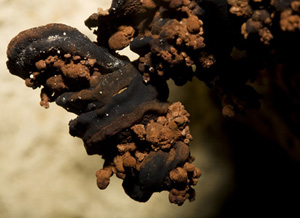Fungi thrive in the damp conditions found underground and play an important part in recycling nutrients by decomposing organic material. Like the heterotrophic bacteria they obtain ready made organic molecules from the tissues of other plants and animals. These food sources are usually dead or decaying but there are some fungi that attack living tissues. The lack of light underground appears to affect the ability of some fungi to produce fruiting bodies (the familiar 'toadstools') and for others to grow into shapes not normally seen on the surface, this can make identification difficult. Most of the larger fungi live on dead and decaying wood and can be seen growing on wood debris washed into caves and on props and other wood in some of the Mendip mines.
The smaller fungi imperfecta e.g. Aspergillus, Penicillium can be found growing on bits of Mars bar or bread that have been dropped, they look like a mould. Some prevent bacteria from growing by secreting antibiotics on their food source – this is why Penicillium is useful in medicine.
It is entirely possible that underground there are species of bacteria and fungi unknown to science that could provide a source of new medicines.
Most fungi will have a preference for the food source, those that live on wood will prefer a certain type of tree and this can be used to help identify it. Unfortunately wood found underground is usually rotten and difficult to identify.
Some of the typical fungi seen underground on wood are:
Honey Fungus Armellia mellea - this is a parasite of conifers and broad leaved trees, and often kills its host. It produces long, black, bootlace like rhizomorphs between the bark and the wood. The mycelium of Honey fungus is also luminescent.
Candle snuff (Xylaria hypoxylon) and Dead Mans Fingers (Xylaria polymorpha) are found on deciduous wood, often beech.
Poriaillanti is a common and serious cause of wood decay in damp mines.
Most fungi are associated with soil and plants but some are found as saprophytes and parasites on cave invertebrates: Paecilomyces on dead insects, and both Beauveria and Hirsutella attack live insects – the latter is often found on the fly Heleomyza serrata. Hirsutella is also a parasite of nematodes - some fungi actually trap and hunt nematodes and springtails and can be regarded as predators.
|


